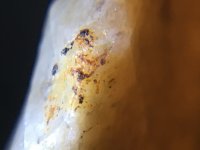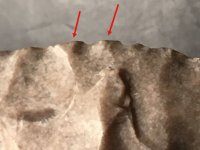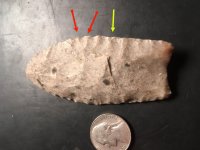This was part of the “Charles Elgin” collection. Not sure who he is ( any ideas)?
Anyways a buddy of mine wants to buy it. Before he does, do you see any issues with it. Supposedly from Ohio or Ky. One thing to point out, there are no copper reminants on the base which is often a clue to a forgery. Also, the edges are dull which does not appear to be freshly knapped. There are several thick deposits (crusty layer) which from what I am told could be faked but are often stains, not thick encrustations and they are hard to remove. Appears to be oxide deposits. These are on several areas of the point. Also looks to have patina?Anyways, do you see any issues and who do you recommend to have
Anyways a buddy of mine wants to buy it. Before he does, do you see any issues with it. Supposedly from Ohio or Ky. One thing to point out, there are no copper reminants on the base which is often a clue to a forgery. Also, the edges are dull which does not appear to be freshly knapped. There are several thick deposits (crusty layer) which from what I am told could be faked but are often stains, not thick encrustations and they are hard to remove. Appears to be oxide deposits. These are on several areas of the point. Also looks to have patina?Anyways, do you see any issues and who do you recommend to have
Attachments
-
 F6C35489-920A-4D8E-BD9A-198A19CA5B27.jpeg570.2 KB · Views: 142
F6C35489-920A-4D8E-BD9A-198A19CA5B27.jpeg570.2 KB · Views: 142 -
 9C48B309-7073-446E-A621-08520484CD47.jpeg433.4 KB · Views: 104
9C48B309-7073-446E-A621-08520484CD47.jpeg433.4 KB · Views: 104 -
 EED936A3-31CD-45B5-BB7E-7F00A943DAFA.jpeg701.3 KB · Views: 116
EED936A3-31CD-45B5-BB7E-7F00A943DAFA.jpeg701.3 KB · Views: 116 -
 046372C3-F348-44F9-B2ED-0537FECD0933.jpeg708.8 KB · Views: 121
046372C3-F348-44F9-B2ED-0537FECD0933.jpeg708.8 KB · Views: 121 -
 15932247-2D09-47D4-86F4-795BD64DFDD8.jpeg1.1 MB · Views: 167
15932247-2D09-47D4-86F4-795BD64DFDD8.jpeg1.1 MB · Views: 167
Upvote
0















